Yin Yoga is a slow-paced style of yoga that involves holding poses for extended periods, typically between 2 to 5 minutes or even longer. This practice targets the deep connective tissues, such as the ligaments, joints, and fascia, rather than the muscles. Unlike more dynamic forms of yoga like Vinyasa or Ashtanga, Yin Yoga is about finding stillness and surrendering into the pose. It’s a meditative approach that enhances flexibility, improves circulation, and promotes a sense of calm.
Teaching Yin Yoga requires a deep understanding of its principles, a compassionate approach to guiding students, and the ability to create a nurturing environment. This article will explore the essential aspects of teaching Yin Yoga, from understanding its philosophy to designing classes that cater to various student needs.
Understanding the Philosophy of Yin Yoga
Before you can effectively teach Yin Yoga, it’s crucial to understand its underlying philosophy. Yin Yoga is rooted in Taoist principles and the concept of yin and yang. In Taoist thought, yin represents qualities such as stillness, introspection, and coolness, while yang represents movement, activity, and warmth. Yin Yoga aims to balance these energies by providing a counterbalance to the more dynamic, yang forms of exercise.
The practice is also influenced by Traditional Chinese Medicine (TCM), which believes that Yin Yoga helps to stimulate the flow of “qi” (life force) through the meridian pathways, promoting overall health and well-being. Understanding these principles will enable you to teach Yin Yoga with authenticity and depth.
Creating a Safe and Comfortable Environment
The environment in which you teach Yin Yoga plays a significant role in the effectiveness of the practice. Since Yin Yoga involves long holds and deep stretching, it’s essential to create a space that feels safe and comfortable for your students. Here are some tips for setting up the perfect Yin Yoga environment:
Lighting: Use soft, dim lighting to create a calming atmosphere. Avoid bright lights that can be harsh and distracting.
Temperature: Ensure the room is warm but not too hot. A comfortable temperature helps students relax and stretch more deeply.
Props: Provide ample props such as bolsters, blankets, blocks, and straps. These props support students in achieving the desired pose without strain.
Ambiance: Play gentle, soothing music or nature sounds to enhance relaxation. Silence is also a powerful tool in Yin Yoga, allowing students to focus inward.
Cleanliness: Ensure the space is clean and free of clutter. A tidy environment promotes a sense of calm and focus.
Preparing Your Students
Before starting a Yin Yoga class, it’s important to prepare your students both physically and mentally. Begin with a brief introduction to Yin Yoga, explaining its principles and benefits. Emphasize the importance of listening to their bodies and finding their edge—the point where they feel a deep stretch but without pain.
Guide your students through a gentle warm-up to prepare their bodies for the long holds. This can include simple movements like cat-cow stretches, gentle twists, and light hip openers. Encourage students to move mindfully and pay attention to how their bodies feel.
Key Principles of Yin Yoga
When teaching Yin Yoga, there are several key principles to keep in mind:
Find Your Edge: Encourage students to find their edge in each pose. This means going to a point where they feel a significant stretch but without pain or discomfort.
Hold for Time: Yin Yoga poses are held for an extended period, typically between 2 to 5 minutes. This allows the connective tissues to slowly and safely stretch and rejuvenate.
Resolve to Be Still: Once in the pose, encourage students to find stillness. This can be challenging, but it’s essential for allowing the body to open and release tension.
Release with Care: When coming out of a pose, guide students to do so slowly and mindfully. Sudden movements can cause injury or disrupt the calming effect of the practice.
Essential Yin Yoga Poses
Here are some foundational Yin Yoga poses that you can incorporate into your classes. Each pose targets different areas of the body and provides various benefits.
Butterfly Pose (Baddha Konasana): Sit with the soles of your feet together and let your knees fall open. Fold forward, allowing your spine to round. This pose stretches the inner thighs, groin, and hips.
Dragon Pose (Anjaneyasana): From a low lunge position, lower your back knee to the ground and sink your hips forward. This pose deeply stretches the hip flexors and quadriceps.
Caterpillar Pose (Paschimottanasana): Sit with your legs extended straight in front of you. Fold forward over your legs, allowing your spine to round. This pose targets the hamstrings and lower back.
Sphinx Pose: Lie on your stomach and prop yourself up on your forearms. This gentle backbend stretches the spine and stimulates the lower back.
Child’s Pose (Balasana): Sit back on your heels and fold forward, bringing your forehead to the ground. Extend your arms in front of you or alongside your body. This pose provides a gentle stretch for the back and hips.
Reclining Twist (Supta Matsyendrasana): Lie on your back and bring one knee into your chest. Guide the knee across your body while keeping your shoulders grounded. This twist releases tension in the spine and massages the internal organs.
Guiding Students Through Poses
When guiding students into Yin Yoga poses, clear and compassionate communication is key. Use descriptive language to help them understand how to position their bodies and find their edge. Here are some tips for effective cueing:
Use Simple, Clear Instructions: Avoid complicated or technical language. Keep your instructions simple and easy to follow.
Encourage Exploration: Remind students that every body is different and encourage them to explore variations of poses to find what feels best for them.
Offer Modifications: Provide modifications for students with different levels of flexibility and experience. Use props to make poses accessible and comfortable.
Observe and Assist: Walk around the room and observe your students. Offer gentle adjustments or verbal cues to help them deepen their practice safely.
See Also: 10 Benefits of Yin Yoga
The Role of Breath in Yin Yoga
Breath awareness is a crucial component of Yin Yoga. It helps students stay present, relax into poses, and release tension. Encourage your students to use their breath as an anchor throughout the practice. Here are some breathing techniques to incorporate:
Deep Belly Breathing: Instruct students to breathe deeply into their bellies, allowing the breath to be slow and steady. This promotes relaxation and helps release tightness in the body.
Ujjayi Breath: Also known as “ocean breath,” this technique involves slightly constricting the back of the throat to create a soft, whispering sound. It can help students maintain focus and calm their minds.
Counting the Breath: Guide students to count their inhales and exhales, aiming for a slow and even rhythm. This can enhance their ability to stay present and deepen their relaxation.
Incorporating Mindfulness and Meditation
Yin Yoga naturally lends itself to mindfulness and meditation. As students hold poses for extended periods, they have the opportunity to cultivate a deep sense of awareness and introspection. Here are some ways to incorporate mindfulness into your Yin Yoga classes:
Guided Meditations: Begin or end your class with a guided meditation to help students settle into a state of mindfulness. Focus on themes such as gratitude, body awareness, or letting go of stress.
Body Scans: During long holds, guide students through a body scan, encouraging them to notice and release any areas of tension.
Mindful Observations: Encourage students to observe their thoughts and sensations without judgment. This practice can help them develop a greater sense of self-awareness and acceptance.
Creating a Balanced Yin Yoga Sequence
Designing a balanced Yin Yoga sequence involves selecting poses that target different areas of the body and arranging them in a logical order. Here’s a sample sequence to get you started:
Opening Meditation (5 minutes): Begin with a seated meditation to center the mind and set an intention for the practice.
Butterfly Pose (3-5 minutes): Open the hips and stretch the inner thighs.
Dragon Pose (3-5 minutes each side): Deeply stretch the hip flexors and quadriceps.
Caterpillar Pose (3-5 minutes): Target the hamstrings and lower back.
Sphinx Pose (3-5 minutes): Gently stretch the spine and stimulate the lower back.
Child’s Pose (3-5 minutes): Provide a gentle stretch for the back and hips.
Reclining Twist (3-5 minutes each side): Release tension in the spine and massage the internal organs.
Savasana (10 minutes): End with a deep relaxation pose to integrate the benefits of the practice.
Conclusion
Teaching Yin Yoga is a deeply rewarding experience that allows you to guide students towards greater physical flexibility, mental clarity, and emotional balance. By understanding the philosophy of Yin Yoga, creating a safe and nurturing environment, and incorporating mindfulness and breath awareness, you can help your students experience the profound benefits of this practice. Remember to approach each class with compassion and an open heart, and you’ll create a space where students can truly transform and grow.
Related topics:























